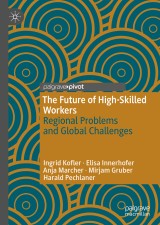Details

The Future of High-Skilled Workers
Regional Problems and Global Challenges|
53,49 € |
|
| Verlag: | Palgrave Pivot |
| Format: | |
| Veröffentl.: | 27.06.2020 |
| ISBN/EAN: | 9783030428716 |
| Sprache: | englisch |
Dieses eBook enthält ein Wasserzeichen.
Beschreibungen
<p></p><p>The nature of work is changing, due to demographic shifts, globalization, and digitization. Regional local labor markets are in global competition for (highly) qualified and specialized workers. At the same time, the workforce’s desire for flexibility and the increasing speed at which skill requirements are changing are producing disparities at the spatial, social, and economic levels.</p><p> </p><p>This book discusses the global and local drivers behind these developments. It explores the factors which cause global inequalities between urban and rural areas, and highlights how cities, regions and countries attract these sought-after employees to address skills shortages. The book includes an in-depth case study on high-skilled workers in South Tyrol, Italy. No single academic discipline can adequately capture the dynamics of the future labor market, and the authors therefore take an interdisciplinary approach, combining insights from different disciplines. This book will be a valuable resource for policymakers, students and researchers seeking to understand the driving forces behind the ever-changing labor market and the future of high-skilled work.</p><p></p>
<b>1. </b><b>Introduction</b><p>The introduction will give an overview on different theoretical approaches used in the study in order to provide readers with an interdisciplinary framework. Moreover, this first chapter will address definitory issues and it will provide with a short overview of the different methods applied throughout the research project. The following chapters are based on literature research and empirical primary and secondary data.</p><p><b>2. </b><b>The future of high-skilled work – main developments and drivers of change</b><b></b></p><p>Chapter Two will describe the main trends shaping the future of work in general, i.e. technology and demographic change, examining existing and future trends.</p><p><b>3. </b><b>The high-skilled of tomorrow</b></p><p>Who are the high-skilled of tomorrow? What skills do they have? Which educational background? Chapter Three will try to answer these questions, outlining the profile of high-skilled workers in terms of qualifications, work prospects and geographical mobility and migration.</p><p><b>4. </b><b>Shaping the future organization of work and life</b></p><p>How should work and workplace be organized, in order to meet high-skilled workers´ needs? Which organizational changes are required by the recent developments? What does work-life-balance will mean in future? Chapter Four deals with these questions and the challenges such issues pose to employees and employers.</p><p><b>5. </b><b>Does “place” matter? The importance of location factors</b></p><p>Chapter Five will discuss the importance of location factors, both from the theoretical and empirical point of view. A section will be devoted in fact to the newly developed European Regions´ Talent Competitiveness Index, the aim of which is measuring one region´s attractiveness for high-skilled workers.</p><p><b>6. </b><b>Specific case study: South Tyrol</b></p>Following the results of the European Regions’ Talent Competitiveness Index, chapter Six will illustrate a specific case study of a European region located in the north of Italy, in order to explore and discuss how the above-described global developments will affect the local level and viceversa. This section introduces data on the current situation on in- and outmigration and on the demand and supply of workers in the region.<p><b>7. </b><b>Discussion and conclusion</b></p><p>The closing chapter will offer some points of reflections for practitioners and policy-makers, alongside with limitations and ideas for further research.</p>
<p></p><p><b>Ingrid Kofler</b> is a sociologist. She is Senior Researcher at the Center for Advanced Studies at Eurac Research in Bolzano, Italy. She has held Visiting Researcher positions at the 21st Century Global Dynamics initiative, the University of California, Santa Barbara, USA, and at the Hamburg Institute of International Economics (HWWI), Germany.</p><p><b>Elisa Innerhofer</b> is a business economist and political scientist. She is Senior Researcher at the Center for Advanced Studies at Eurac Research.</p><p><b>Anja Marcher</b> is a geographer and researcher at the Center for Advanced Studies at Eurac Research. She is also a Junior Fellow at the Institute for Advanced Studies (IHS) in Vienna, Austria.</p><p><b>Mirjam Gruber </b>is a political scientist. She is a researcher at the Center for Advanced Studies of Eurac Research, and a PhD candidate at the University of Leipzig’s Institute of Political Science.</p><p> </p><p><b>Harald Pechlaner </b>is a business economist. He is Head of the Center for Advanced Studies at Eurac Research, and Professor of Tourism and Head of the Center for Entrepreneurship at the Catholic University of Eichstätt-Ingolstadt, Germany.</p><p></p>
<p>The nature of work is changing, due to demographic shifts, globalization, and digitization. Regional local labor markets are in global competition for (highly) qualified and specialized workers. At the same time, the workforce’s desire for flexibility and the increasing speed at which skill requirements are changing are producing disparities at the spatial, social, and economic levels.</p><p></p><p>This book discusses the global and local drivers behind these developments. It explores the factors which cause global inequalities between urban and rural areas, and highlights how cities, regions and countries attract these sought-after employees to address skills shortages. The book includes an in-depth case study on high-skilled workers in South Tyrol, Italy. No single academic discipline can adequately capture the dynamics of the future labor market, and the authors therefore take an interdisciplinary approach, combining insights from different disciplines. This book will be a valuable resource for policymakers, students and researchers seeking to understand the driving forces behind the ever-changing labor market and the future of high-skilled work.<br></p>
<p>Describes the main trends shaping the future of work in general including technology and demographic change</p><p>Offers points of reflections for practitioners and policy-makers</p><p>Identifies who are the high-skilled workers of tomorrow by outlining their profile in terms of qualifications, work prospects, migration and geographic mobility</p>
Diese Produkte könnten Sie auch interessieren:

Die Festlegung von Wesentlichkeitsgrenzen im Rahmen der Abschlussprüfung

von: Elina Valpetere

18,99 €















